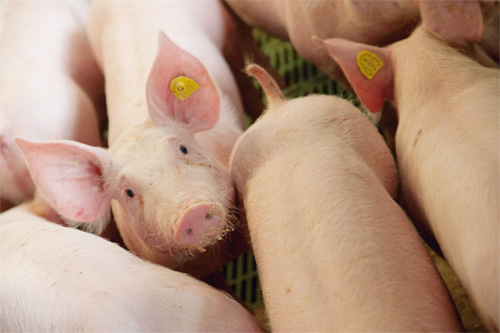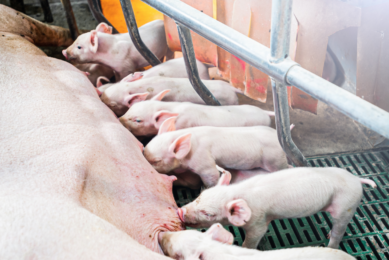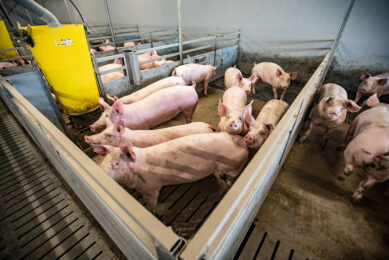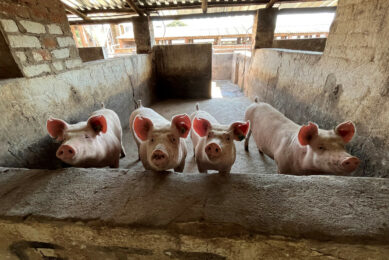Permeabilisers help target a wider range of bacteria

With antibiotic growth promoters banned in the EU, the demand grows for natural ways to create a bacterial balance in pig and poultry gut systems. As knowledge grows, so does the number of approaches – and their subsequent synergy. The latest introduction to the market combines organic acids, a phytochemical with a cell wall permeabiliser – to boost the antimicrobial effect of the other components.
Pigs, as well as other animals and plants live in symbiosis with different bacteria. They can protect the host for example from the colonisation of pathogenic bacteria, regulate the development of the gut or produce vitamins and hormones for the host, while some bacteria are also known to cause diseases.
The presence of bacteria within the gastrointestinal tract, however, leads to the competition of the host animal and the bacterial population for nutrients. Bacteria furthermore secrete toxic compounds, i.e. toxic amino acid catabolites, decrease fat digestibility, stimulate rapid turnover of absorptive epithelial cells, require an increased rate of mucus secretion by intestinal goblet cells and stimulate immune system development and inflammatory responses. All of these effects lead to impaired growth performance and research has demonstrated that as much as 6% of the net energy in pig diets is lost to the microflora.
Therefore, it is not only highly important to control possibly harmful bacteria, but also to keep the bacterial population within the gut well balanced. Already a long time ago organic acids were identified to be able to alter the gastro-intestinal microflora by reducing in particular acid-intolerant bacterial species such as E.coli, Salmonella and Campylobacter resulting in increased growth performance. However, it was also shown, that organic acids have limited effect in low concentrations. Gram-negative bacteria, however, are equipped with an additional outer membrane, providing resistance to antibiotics and detergents. A different approach is therefore needed for this type of bacteria – more about that later.
Acidifier market
Europe is the biggest market for acidifiers and is expected to continue to grow over the next years. The opinions about the growth potential of the other markets such as Asia, South America or Russia differ. There is a mutual consent that propionic acid has the largest potential on the market due to its characteristics as being a readily digestible energy source and active against fungi and bacteria resulting in its characteristics as mould inhibitor.
Europe is the biggest market for acidifiers and is expected to continue to grow over the next years. The opinions about the growth potential of the other markets such as Asia, South America or Russia differ. There is a mutual consent that propionic acid has the largest potential on the market due to its characteristics as being a readily digestible energy source and active against fungi and bacteria resulting in its characteristics as mould inhibitor.
Different levels of agreement exist when it comes to fumaric acid. Some predict that fumaric acid will be less and less important due to its cost and the high optimum dose rate. Others prognosticate that demand will not decrease as fumaric acid is poorly absorbed by the intestine and therefore can pass further along the gastro-intestinal tract. Experts also agree that formic and lactic acid will play an important role on the acidifier market as they are stronger than fumaric acid. Also the benefits of using organic acid blends instead of single acids will be continuously used in livestock production. However, besides varying the acids within the acid blends and the inclusion levels of the single acids, innovations are hard to find.
Phytochemicals from essential oils
Often organic acids are combined with other naturally derived products, like essential oils. They are often mixed with organic acids, in an attempt to use possible synergy to combat pathogenic bacteria. Essential oils in general serve as antioxidants, stimulate the immune system, suppress harmful micro-organisms on one side but stimulate beneficial microbes on the other, they regulate the activity of enzymes especially lipase, are known to protect the gut villi and to interfere with the DNA replication of bacterial cells and therefore have anti-bacterial effects.
Often organic acids are combined with other naturally derived products, like essential oils. They are often mixed with organic acids, in an attempt to use possible synergy to combat pathogenic bacteria. Essential oils in general serve as antioxidants, stimulate the immune system, suppress harmful micro-organisms on one side but stimulate beneficial microbes on the other, they regulate the activity of enzymes especially lipase, are known to protect the gut villi and to interfere with the DNA replication of bacterial cells and therefore have anti-bacterial effects.
There is, however, a large variety in modes of action for the several phytochemicals derived from essential oils available. One of the more useful phytochemicals is cinnamaldehyde, a phytochemical derived from cinnamon bark oil. Its benefits largely relate to its inhibiting effect on the so-called FtsZ protein, as it plays a major role in the cell division of potentially harmful bacteria. Under normal circumstances, FtsZ polymerises into filaments, which assemble at the place within the cell, where the cell division takes place. There they form into a polymeric structure known as the ‘Z-ring’ on the inner membrane in the middle of the cell, which is responsible for the cell’s division.
Cinnamaldehyde inhibits not only the formation of FtsZ into filaments, but also inhibits essential processes involved in the Z-ring formation and its function and thus the cell division. This results in a reduction of the bacterial load, within the gastro-intestinal tract.
Gram-negative bacteria
Having developed methods to target gram-positive bacteria, as well as having found ways to target cell division, an approach to more effectively deal with gram-negative bacteria would make the picture more complete. As indicated, gram-positive and gram-negative bacteria differ in their outer structure.
Having developed methods to target gram-positive bacteria, as well as having found ways to target cell division, an approach to more effectively deal with gram-negative bacteria would make the picture more complete. As indicated, gram-positive and gram-negative bacteria differ in their outer structure.
In general, cytoplasm of any cell is surrounded by cytoplasmic membrane. In gram-negative bacteria, however, an additional outer membrane can be found, which provides them with an inherent resistance to hydrophobic antibiotics and detergents. Weakening this outer membrane is possible by agents commonly characterised as permeabilisers. All the permeabilising substances act quite differently; some of them remove stabilising cations from the outer membrane, while others bind to the outer membrane resulting in the loss of barrier function. Others again destabilise or disintegrate the outer membrane or displace cations from the outer membrane causing membrane damage.
In theory, when organic acids are used in combination with permeabilisers, the outer membrane of gram-negative bacteria could be weakened, and the activity of other antimicrobials would be increased by facilitating external substances capable of inhibiting or destroying cellular functions when entering into the cells. Whether a synergy can be found in practice, highly depends on the right combination of organic acids and permeabilising substances. Not with every combination will synergy be found.
Effects on animal performance
Austrian animal nutrition company Biomin aimed to combine the best of three worlds: the company tested the effect on bacterial growth of an acid mixture, combined with a phytochemical (cinnamaldehyde) and a permeabilising substance, called Biomin Perforizer.
Austrian animal nutrition company Biomin aimed to combine the best of three worlds: the company tested the effect on bacterial growth of an acid mixture, combined with a phytochemical (cinnamaldehyde) and a permeabilising substance, called Biomin Perforizer.
In vitro, this was shown in research at the company’s research center in Tulln, Austria. Synergistic effects were found when adding the permeabilising substance to the mixture of organic acids and a phytochemical, indicating that the permeabilisation of the outer membrane of gram-negative bacteria facilitates organic acids to penetrate the gram-negative cell destroying cellular functions, leading to cellular death. This was also shown to effect animal growth performance, indicating that the host animal does not have to compete for nutrients with pathogenic bacteria. A trial to test the natural growth promoter (NGP) in vivo was carried out at the Centre of Applied Animal Nutrition (Mank, Austria), using 60 weaning pigs [(Landrace x Large White) x Piétrain].
Pigs were assigned to two treatments with three replicate pens per treatment and ten pigs per pen. Pigs were fed a cereal based starter diet between day 1 to 14 (13.7 MJ ME, 17.27% crude protein, 1.37% lysine) and a cereal based grower diet (13.0 MJ ME, 19.7% crude protein, 1.18% lysine) from day 15 until the end of the trial. The control group diet contained no feed additives, whereas the diet of the trial group was supplemented with the NGP at an inclusion rate of 1.0 kg/t feed. The duration of the trial was 56 days.
Supplementing the diets with the natural growth promoter enhanced the pigs’ growth performance. Body weight at day 56 was by 6% (P<0.05) higher in the trial group compared to the control group (Figure 1). Average daily gain was improved by 8% in the NGP group compared to the group with no NGP added (Figure 2) and also feed conversion ratio was improved by 3% (P>0.05) in the NGP group compared to the control group (Figure 3). However, differences in FCR were not significant.
In short, the synergy caused by the inclusion of the permeabilising substance boosts the effect of the antimicrobial ingredients, resulting in economical benefits for the end user. Therefore, it presents a different strategy to act against bacteria. The company has launched the NGP as Biotronic Top 3.
Source: Pig Progress magazine Volume 27. No.3











